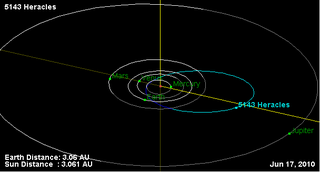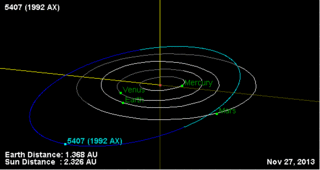Gallery
- Orbit of 1998 PG
- The 1998 PG system compared to other binary asteroids
| Discovery [1] | |
|---|---|
| Discovered by | LONEOS |
| Discovery site | Anderson Mesa Stn. |
| Discovery date | 3 August 1998 |
| Designations | |
| (31345) 1998 PG | |
| 1998 PG | |
| NEO · Amor [1] [2] | |
| Orbital characteristics [1] | |
| Epoch 4 September 2017 (JD 2458000.5) | |
| Uncertainty parameter 0 | |
| Observation arc | 38.54 yr (14,075 days) |
| Aphelion | 2.8048 AU |
| Perihelion | 1.2277 AU |
| 2.0162 AU | |
| Eccentricity | 0.3911 |
| 2.86 yr (1,046 days) | |
| 215.36° | |
| 0° 20m 39.48s / day | |
| Inclination | 6.5013° |
| 222.74° | |
| 156.11° | |
| Known satellites | 1 [3] [4] [5] [a] |
| Earth MOID | 0.2354 AU ·91.7 LD |
| Physical characteristics | |
| Dimensions | 0.880 km (derived) [6] 0.9±0.2 km [5] [a] 0.940±0.21(derived) [4] |
| 2.5 h [7] 2.51620±0.00003 h [3] | |
| 0.18 [5] [a] 0.20 (assumed) [6] | |
| SMASS = Sq [1] · S [6] B–V = 0.810±0.020 [3] V–R = 0.440±0.010 [3] V–I = 0.760±0.020 [3] | |
| 17.3 [1] ·17.64±0.14 [3] [6] [8] | |
(31345) 1998 PG is an eccentric, stony asteroid and binary system, classified as near-Earth object of the Amor group of asteroids, approximately 900 meters in diameter. It minor-planet moon, S/2001 (31345) 1, has an estimated diameter of 270 meters.
This asteroid was discovered on 3 August 1998, by the Lowell Observatory Near-Earth-Object Search (LONEOS) at Anderson Mesa Station, near Flagstaff, Arizona, United States. [2]
1998 PG orbits the Sun at a distance of 1.2–2.8 AU once every 2 years and 10 months (1,046 days). Its orbit has an eccentricity of 0.39 and an inclination of 7° with respect to the ecliptic. [1] A first precovery was taken at Palomar Observatory in 1978, extending the body's observation arc by 20 years prior to its official discovery observation at Anderson Mesa. [2]
The asteroid has an Earth minimum orbital intersection distance of 0.2354 AU (35,200,000 km), which translates into approximately 92 lunar distances. It has made multiple close approaches to Earth, with the closest being 35,648,680 kilometers on 15 October 1978. [1] With an aphelion of more than 2.8 AU, 1998 PG is also a Mars-crosser.
In the SMASS taxonomy, 1998 PG is classified as a transitional Sq-type, which is an intermediary between the common stony S-type and the less frequent Q-type asteroids. [1]
According to the 2006-published Photometric survey of binary near-Earth asteroids by Petr Pravec and derived data from the Collaborative Asteroid Lightcurve Link and the "Johnston's archive", 1998 PG measures between 880 and 940 meters in diameter and its surface has an albedo of 0.18 and 0.20, respectively. [4] [5] [6] [a]
In the late 1990s, a rotational lightcurve of 1998 PG was obtained from photometric observations by Hungarian astronomers László Kiss, Gyula Szabó and Krisztián Sárneczky. Lightcurve analysis gave a rotation period of 2.5 hours with a brightness variation of 0.1 magnitude ( U=n.a. ). [7]
A second lightcurve obtained and published in 2000, by an international collaboration of astronomers gave a rotation period of 2.51620±0.00003 hours with a brightness amplitude of 0.11 magnitude ( U=2 ). [3]
During the second photometric observation, it was discovered that 1998 PG is a probable/possible asynchronous binary system with a minor-planet moon orbiting it every 7.0035 hours, [6] or twice this period solution. [4]
The moon's provisional designation is S/2001 (31345) 1. [4] The system has an estimated secondary-to-primary mean-diameter ratio of more than 0.3, [3] [a] which translates into a diameter of 270 meter for the satellite. [4] The "Johnston's archive" also estimates that the moon's orbit has a semi-major axis of 1.4 kilometers. [4]
From the surface of 1998 PG, the moon would have an angular diameter of about 16.3°. [b] For comparison, the Sun appears to be 0.5° from Earth.
This minor planet was numbered by the Minor Planet Center on 30 November 2001. [9] As of 2018, it has not been named. [2]
11264 Claudiomaccone (provisional designation 1979 UC4) is a stony background asteroid and binary system from the middle regions of the asteroid belt, approximately 3 kilometers in diameter. It was discovered 16 October 1979, by Nikolai Chernykh at Crimean Astrophysical Observatory in Nauchnyj, on the Crimean peninsula. It was named after the Italian astronomer Claudio Maccone.
6084 Bascom, provisional designation 1985 CT, is a binary Phocaea asteroid from the inner regions of the asteroid belt, approximately 6.3 kilometers in diameter. It was discovered on 12 February 1985, by American astronomer couple Carolyn and Eugene Shoemaker at Palomar Observatory in California. It is named after American geologist Florence Bascom. Its satellite measures approximately 2.3 kilometers and has an orbital period of 43.51 hours.
4029 Bridges, provisional designation 1982 KC1, is a stony asteroid and binary system from the middle regions of the asteroid belt, approximately 8 kilometers in diameter.

1338 Duponta, provisional designation 1934 XA, is a stony Florian asteroid and synchronous binary system from the inner regions of the asteroid belt, approximately 7.8 kilometers in diameter.
7369 Gavrilin, provisional designation 1975 AN, is a stony Phocaean asteroid, sizable Mars-crosser, and binary system on an eccentric orbit from the inner regions of the asteroid belt, approximately 5.5 kilometers in diameter. It was discovered on 13 January 1975, by Russian astronomer Tamara Smirnova at the Crimean Astrophysical Observatory in Nauchnyj, on the Crimean peninsula. The assumed S-type asteroid has a long rotation period of 49.1 hours. It was named after Russian composer Valery Gavrilin. The discovery of its 2.4-kilometer sized minor-planet moon was announced in October 2008.

5143 Heracles is a highly eccentric, rare-type asteroid and synchronous binary system, classified as near-Earth object of the Apollo group, approximately 4.8 kilometers in diameter. The asteroid was discovered on 7 November 1991, by American astronomer Carolyn Shoemaker at Palomar Observatory in California, United States. It is named for the Greek divine hero Heracles. It has an Earth minimum orbit intersection distance of 0.058 AU (8.7 million km) and is associated with the Beta Taurids daytime meteor shower.
7088 Ishtar, provisional designation 1992 AA, is a synchronous binary asteroid and near-Earth object from the Amor group, approximately 1.3 kilometers in diameter. It was discovered on 1 January 1992, by American astronomer Carolyn Shoemaker at the Palomar Observatory in California. The relatively bright asteroid with an unknown spectral type has a rotation period of 2.7 hours. In December 2005, a 330-meter sized satellite was discovered, orbiting its primary every 20.65 hours.
4951 Iwamoto, provisional designation 1990 BM, is a stony, synchronous binary asteroid and slow rotator from the inner regions of the asteroid belt, approximately 5.5 kilometers in diameter. It was discovered on 21 January 1990, by Japanese astronomers Yoshikane Mizuno and Toshimasa Furuta at Kani Observatory in Japan.
5481 Kiuchi, provisional designation 1990 CH, is a bright binary Vestian asteroid from the inner regions of the asteroid belt, approximately 4 kilometers in diameter. It was discovered on 15 February 1990, by Japanese astronomers Kin Endate and Kazuro Watanabe at Kitami Observatory in Hokkaidō, Japan, and named after their colleague Tsuruhiko Kiuchi. The V-type asteroid has a rotation period of 3.6 hours.
6244 Okamoto, provisional designation 1990 QF, is a background asteroid and binary system from the inner regions of the asteroid belt, approximately 5 kilometers in diameter. It was discovered on 20 August 1990, by Japanese astronomer Tsutomu Seki at the Geisei Observatory in Kōchi, Japan, and later named after Japanese school teacher Hiroshi Okamoto. The presumed S-type asteroid has a short rotation period of 2.9 hours. The discovery of its minor-planet moon was announced in October 2006.
2815 Soma, provisional designation 1982 RL, is a binary Florian asteroid from the inner regions of the asteroid belt, approximately 7 kilometers in diameter. It was discovered on 15 September 1982, by American astronomer Edward Bowell at Lowell's Anderson Mesa Station in Flagstaff, Arizona, in the United States. It is named for the mechanical puzzle Soma cube.
13123 Tyson, provisional designation 1994 KA, is a stony Phocaea asteroid and an asynchronous binary system from the inner regions of the asteroid belt, approximately 10 kilometers in diameter. It was discovered on May 16, 1994, by American astronomer Carolyn Shoemaker and Canadian astronomer David Levy at the Palomar Observatory in California, United States. The asteroid was named for Neil deGrasse Tyson, American astrophysicist and popular science communicator.

4765 Wasserburg (prov. designation: 1986 JN1) is a bright Hungaria asteroid, suspected binary system and asteroid pair from the innermost regions of the asteroid belt, approximately 3 kilometers (1.9 miles) in diameter. It was discovered on 5 May 1986, by American astronomer Carolyn Shoemaker at Palomar Observatory, and later named after geologist Gerald J. Wasserburg.
3982 Kastelʹ, provisional designation 1984 JP1, is a Florian asteroid and a suspected binary system from the inner regions of the asteroid belt, approximately 6.9 kilometers in diameter.

(5407) 1992 AX, provisional designation 1992 AX, is a stony asteroid and a synchronous binary Mars-crosser from the innermost region of the asteroid belt, approximately 3.6 kilometers in diameter. It was discovered on 4 January 1992, by Japanese astronomers Seiji Ueda and Hiroshi Kaneda at the Kushiro Observatory on Hokkaidō, Japan. The S-type asteroid has a short rotation period of 2.5 hours. Its sub-kilometer satellite was discovered in 1997. As of 2018, the binary system has not been named.
5477 Holmes, provisional designation 1989 UH2, is a Hungaria asteroid and binary system from the innermost regions of the asteroid belt, approximately 3 kilometers (2 miles) in diameter. It was discovered on 27 October 1989, by American astronomer Eleanor Helin at the Palomar Observatory in California. The presumed E-type asteroid is likely spherical in shape and has a short rotation period of 2.99 hours. It was named for American amateur astronomer Robert Holmes. The discovery of its 1-kilometer-sized minor-planet moon was announced in November 2005.

(175706) 1996 FG3 is a carbonaceous asteroid and binary system, classified as near-Earth object and potentially hazardous asteroid of the Apollo group, approximately 1.7 kilometers (1.1 miles) in diameter. The primary has a spheroidal shape. Its minor-planet moon measures approximately 490 meters (1,600 feet) in diameter.

(66063) 1998 RO1 is a stony near-Earth object of the Aten group on a highly-eccentric orbit. The synchronous binary system measures approximately 800 meters (0.50 miles) in diameter. It was discovered by astronomers of the Lincoln Near-Earth Asteroid Research at the Lincoln Laboratory's Experimental Test Site near Socorro, New Mexico, on 14 September 1998.
32008 Adriángalád (provisional designation 2000 HM53) is a background asteroid and synchronous binary system from the inner regions of the asteroid belt, approximately 4 kilometers (2.5 miles) in diameter. It was discovered on 29 April 2000, by astronomers with the LINEAR program at Lincoln Laboratory's Experimental Test Site near Socorro, New Mexico, in the United States. The V-type asteroid has a rotation period of 3.0 hours. It was named for Slovak astronomer Adrián Galád. Its 1.6-kilometer sized minor-planet moon was discovered in August 2007.
(15700) 1987 QD is a Mars-crossing asteroid and a binary candidate from inside the innermost region of the asteroid belt, approximately 3 kilometers in diameter. It was discovered on 24 August 1987, by American astronomer Stephen Singer-Brewster at the Palomar Observatory in California. The likely spherical X-type asteroid has a rotation period of 3.1 hours. The suspected presence of a kilometer-sized minor-planet moon was announced in November 2000.